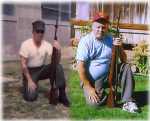Made in Japan----------part III
Many years ago, the term, "Made in Japan" was used to describe products that were very cheaply made----in many cases, basically "junk."
While they HAVE come a long way in quality over the years, I have a World War II pistol in my collection that might have STARTED that phrase. It is the Type 94.
Originally introduced in 1934, the Type 94 is considered by most experts to be the WORST combat handgun ever designed, and I find that pretty hard to argue with. While the Japanese Type 14 is a collector's item, the 94 is NOT, except as something to ridicule, so when I FOUND an ugly little "94" at a gunshow in Phoenix several years ago, I HAD to have it........."just because". (There might not actually be too many of them out there, because NOBODY wanted one as a souvenir!)
Because it was small in size, it was felt to be the ideal sidearm for airmen and tank crew members. Like the more popular Type 14, the 94 was ALSO chambered for the Japanese 8mm Nambu cartridge.....but that's pretty much where the similarity ended.
The little gun was cheaply-made, and there obviously wasn't a lot of quality control at the plant. It malfunctioned frequently, you often couldn't hit anything with it and if you DID, you really needed to be right on the money, because the 8mm Nambu cartridge doesn't have a lot of "steam" behind it.
The guy I bought it from had a box of ammo to go with it. I took it out to Rio Salido Range in Mesa and put 5 rounds through it, just enough to see where it shot----IF it shot. It does. I still have the remaining 45 rounds of ammo and have not fired the gun SINCE.....because ammo is extremely hard to find for it, There IS, or WAS, a guy in Arizona who handloads ammo for it though....but it's pricey.
Via the serial number, MINE was made in 1944 and by THIS time, Japan was pretty much beaten down to "cottage industry" and the quality of weapons was really suffering. In the case of some types of weapons, a safety device might take 3 hours to build and fit, and in that amount of time, they could be building another weapon, so the gun might go WITHOUT that safety device! They were melting down cooking pots to get the metal material, they took copper coins out of circulation to make copper jackets for bullets.....you name it.......those were desperate times.
Think it's tough trying to find a box of 32 Special for your old Winchester, or 41 Magnum for that Smith & Wesson? Try tracking down a box of 8mm Jap Nambu! You aren't going to WalMart or Cabela's for any of THIS!
Our Type 94 is joined here by the Luger, and the German pistol that replaced IT......the Walther P-38. In this photo next to it, is our American pistol that opposed them, the old "standby" Model 1911, 45 automatic. The 45 auto served our military faithfully for 72 years until DOD decided to "replace" it with the "wimpy" little 9mm Beretta in 1983.............I'm STILL trying to figure THAT one out!
The "94" was often more of a hazard to the owner than to the opponent. My pencil-tip is pointing to the EXPOSED SEAR! (the sear is what trips the hammer when you squeeze the trigger, and is always INSIDE of the gun.--------not on the Type 94! Enough pressure on that OUTSIDE sear and the gun (if it had a live round in the chamber) would go off! If you had it loaded & holstered, and just FELL against something "holster-first", your own weight would be enough to press against that sear and you'd shoot yourself in the leg or foot.
(I had already seen the film on Japanese weapons of World War II, BEFORE I ever bought this gun,,,,,,,so I was well aware of this wicked little trait before I ever took it out.). To this day, I NEVER keep it loaded!
-
-- Posted by KH Gal on Mon, Oct 24, 2011, at 11:25 AM
Posting a comment requires free registration:
- If you already have an account, follow this link to login
- Otherwise, follow this link to register







